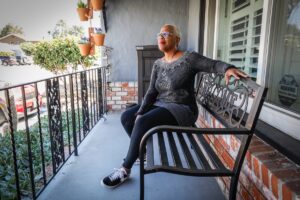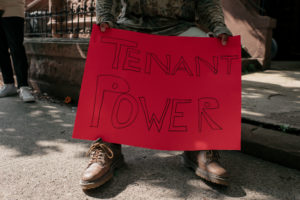Landlords of Alameda County: How an eviction ban stole one couple’s American Dream

In Alameda County, California, a pandemic-era eviction ban has been in place for almost three years, even though COVID no longer poses the same threat it once did.
As a result, “mom and pop” landlords have found themselves losing their livelihoods and dealing with problematic, and sometimes violent, tenants with no way to get rid of them, and with little sympathy or support from their local government.
This is part two in a series shining a light on the landlords of Alameda County who are being hurt by this unconstitutional ban.
————————————————————
Sheanna and Karl Rogers thought they had attained their American Dream when they bought their first home. What they got was a nightmare—one that could have been avoided if Alameda County, California, hadn’t stripped property owners of their right to evict a violent tenant.
Planting roots
As a young married couple in their early 20s, the Rogerses were thrilled to become homeowners. Buying a home at such a young age wasn’t easy, but they never expected it to be. The couple knew what they wanted, and they worked with the owner of the property to settle on an arrangement that would make their dream possible.
To them, that first property represented more than just a house; it was the home where they would plant their family’s roots. As the years passed, the family of two became a family of four, with a third baby on the way. In need of more space, the Rogerses moved into a bigger home.
Mindful of trying to provide a better life and a legacy for their children, they kept the first house and turned it into a rental property.
Years later, in 2010, they hit a bump in the road when Karl lost his job unexpectedly.
The Rogerses have the kind of work ethic that is in short supply these days. They don’t expect anything to be handed to them, and when life throws them lemons, they make the best damn lemonade you’ve ever tasted.
When trying to decide what to do next in his professional life, Karl had the idea to turn their rental property into a residential care home facility for adult males with mental health issues.
This project was close to Karl’s heart. His brother has schizophrenia, and while he can manage many of his basic needs, he could not live on his own.
Karl wanted to give his brother and others like him the self-worth and dignity that come from independence. The facility would provide a safe environment where residents would be under the care of a house manager who helped prepare meals, administer medication, and arrange transportation to doctor visits.
The plan was put into action and the Rogerses began working with an agency called STRIDES, which connected them with potential residents.
The partnership was great for both parties. The agency had nurses that handled the clients’ doctor appointments and case workers that ran point between the residents, their families, and the Rogerses. The Rogerses were responsible for making sure the residents had three meals a day and got their medication on time, as well as ensuring there was always a house manager onsite.
Everything was running smoothly until an act of kindness on the couple’s part put the family and their clients in physical danger.
The dream becomes a nightmare
The rental property also contained a studio apartment. A childhood friend reached out to Karl and asked if he would rent the unit to a friend in need of a place to stay until he got back on his feet. The arrangement was supposed to be temporary and would provide the couple with an additional $1,000 per month.
Without any logical reason to turn down the additional stream of income, the Rogerses agreed and their new tenant Ryan* moved into the unit.
That’s when the Rogerses’ problems began.
The couple’s studio rental was one below the assisted living unit, and it didn’t take long for the proximity to become a problem. The couple began receiving reports that Ryan had been offering drugs to the other tenants, ranging in severity from cannabis to meth.
The worst was still to come.
As the days went on, Ryan became hostile and increasingly more belligerent, threatening the tenants and the house manager who lived there. At one point, Ryan pulled out a gun and started waving it in the air while screaming obscenities at the house manager, who just so happened to capture the incident on camera and alerted the police.
That didn’t put a stop to the erratic behavior.
This contentious situation came to a boiling point when Ryan beat one of the residents with a crowbar, resulting in his arrest and a restraining order.
With the assault now on record and the couple at wits’ end, they began the eviction process in 2019.
Ryan was furious.
Whenever he saw the Rogerses, he would get right in their faces, hurling spine-shivering threats. He once warned, “Keep on pushing this eviction thing and you are going to find yourself six feet under.” At one point, Sheanna’s brother was on the property and heard Ryan on the phone telling the other caller, “Oh yes, they think I’m playing with them. I’ve killed people before. I will hurt them.”
The Rogerses refused to be intimidated. While they pursued the eviction, Ryan sought help from a free legal service to help him fight back.
With nothing to lose and no intention to leave, he stopped paying rent altogether.
The legal back-and-forth between the two parties dragged on until an agreement was finally reached in the beginning of February 2020. Ryan promised to vacate the property by April 1. There was a light at the end of the tunnel now that the Rogerses were just two weeks away from the end of this hellish ordeal.
And then the world stopped.
The pandemic begins
The Rogerses had no idea in February 2020 how the world would change over the short period of a month. By the second week of March, the country was on lockdown and governments of all sizes began passing emergency measures.
In Alameda County, one of the first orders of business was to ban landlords from evicting tenants…for any reason.
On the one hand, the county’s actions were, at the very least, understandable. Widespread COVID closures had put many people out of work indefinitely, making it harder to pay rent each month. This was not the time to throw people out into the streets.
On the other hand, the ban was not just protecting people with legitimate financial challenges. The eviction moratorium applied to everyone, even tenants who posed serious safety concerns.
Yet, at the same time, the government is not allowed to strip individual property owners of their rights. The Constitution forbids it.
But, in the eleventh hour, Ryan was given a reprieve from his eviction at the Rogerses expense.
Sheanna and Karl are no strangers to the severity of the county’s homelessness problem. As active members of their community, they’ve volunteered to help the homeless and other community causes. The last thing they want is to see more people living on the streets.
But tackling homelessness is not the responsibility of individual landlords, many of whom earn their income primarily from their rental units. These aren’t big-time landlords with hundreds of properties and tenants.
“You can’t lump all of the landlords [together]. Because everybody has an individual story. I’m not a corporation. I don’t own multiple properties. That was everything we had. And that is the same for so many other landlords. And we are the ones that are paying for Ryan’s existence,” Sheanna says.
She continued:
“I also think it’s unfair that you are looking at every landlord as having capital just to lose and it’s not going to affect. What about people like us?”
Eventually, the case workers were concerned for the safety of the residents, as were the Rogerses. Not even jail time curbed Ryan’s behavior. Eventually, the Rogerses had no choice but to end their relationship with STRIDES and get the tenants out before something worse could happen.
At this point, the couple has lost the income they were earning from the independent living facility. With Ryan now refusing to give them a penny of the money he owed, the Rogerses’ income was limited. The pandemic did nothing to soften Ryan’s behavior. He continued to cause trouble for the Rogerses and the entire neighborhood.
With their hands tied, there is nothing the Rogerses can do to remedy the situation. The property they worked so hard to buy is being destroyed by Ryan.
To make matters worse, Ryan has tried to squeeze more money out of the Rogerses, suing them three times over bogus claims. None of his attempts have been successful.
The ban goes on
Alameda County’s eviction ban is a major attack on the Constitution. Individuals are guaranteed the right to their own property. If the government wants to take it or use it in any way, like Alameda County has, they must provide just compensation as the Takings Clause of the Fifth Amendment requires.
No such compensation has been given and landlords like the Rogerses are left to carry not only the financial burden, but also burdens to their safety and their mental well-being.
Ryan has been making the most of his cushy situation, buying new cars and even a boat. He also moved his son into the unit, where they both lived rent-free.
Sheanna lamented, “I can’t get him out of my house. I own the house. The American Dream is almost impossible for a lot of black people, period. But now we can’t get this man out of our home.”
Emergency orders are meant to be temporary. Now three years removed from the start of the pandemic, most COVID restrictions have been lifted. But Alameda County has refused to budge.
There is no reason for the county to continue to protect tenants like Ryan who have done nothing but terrorize their landlords.
At one point during this exhausting ordeal, Sheanna made a passionate plea to a judge, who sympathized with the situation.
As Sheanna recalls the judge saying, “These are the kind of things that don’t let me sleep at night. This is why I don’t like this moratorium. These are the hard things that I have to struggle with.”
Sympathy means little when nothing has been done to correct the situation.
Luckily, the Rogerses learned about Pacific Legal Foundation and our lawsuit against the county’s unconstitutional eviction ban, and we are now representing them, along with other landlords who are fighting for their constitutional rights.
Unfortunately, the suit has hit some bumps in the road. But that doesn’t mean we have stopped trying.
Winning this case and getting Ryan out would mean everything to the Rogerses.
“Oh, my goodness. It means, it would mean finally victory. Right now, there’s, it’s like there’s a dark cloud, for lack of better words,” Sheanna told PLF.
“It will mean so much to be able to attain and go back to all of the things that we’ve worked so hard to get to. I mean, we’ve worked really hard to get here. It’s changing everything. We’re getting closer and closer to retirement. We had all these plans about that. Now what are we, four years, three years delayed—three, four years delayed.”
As trying as the past few years have been, Sheanna still feels very blessed they have been able to do what they needed to do to pay their bills.
“I thank the Lord that I’m able to still live life and I’m free.”
At this point, Ryan owes them somewhere close to $30,000, which the Rogerses are willing to sacrifice just to get him out.
This isn’t an isolated issue impacting the Rogers alone. There are small-time landlords across the county who are being robbed of their property rights and their income over an emergency measure that should have ended long ago. And the county doesn’t seem to care.
*Name has been changed out of concern for the Rogerses’ safety.






